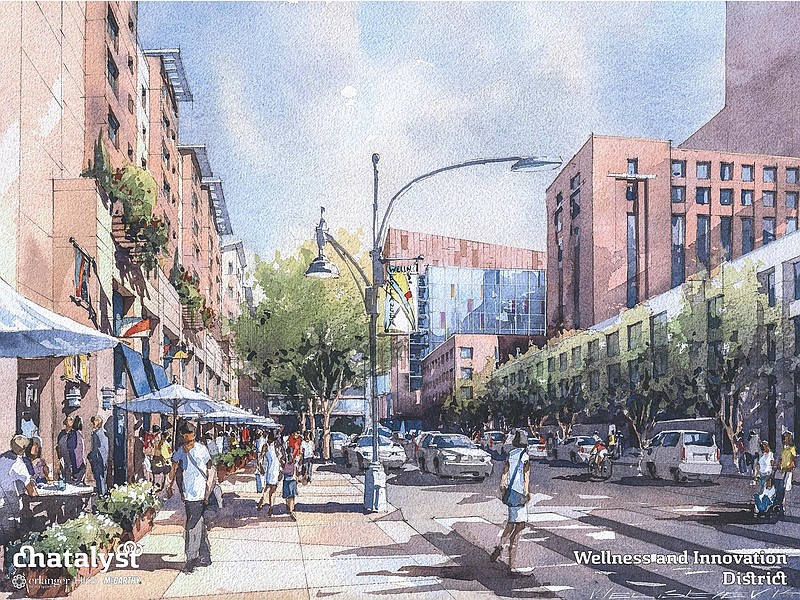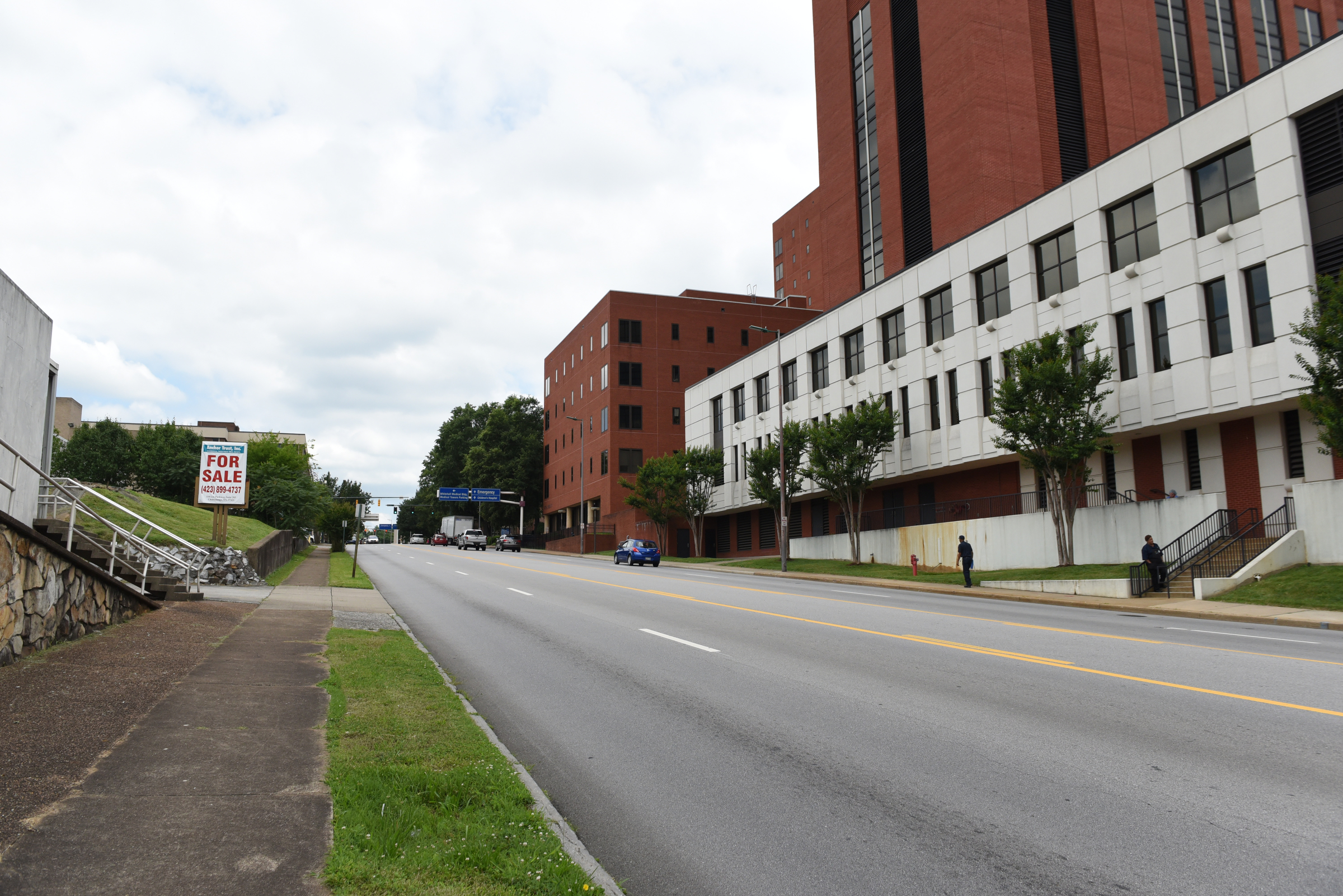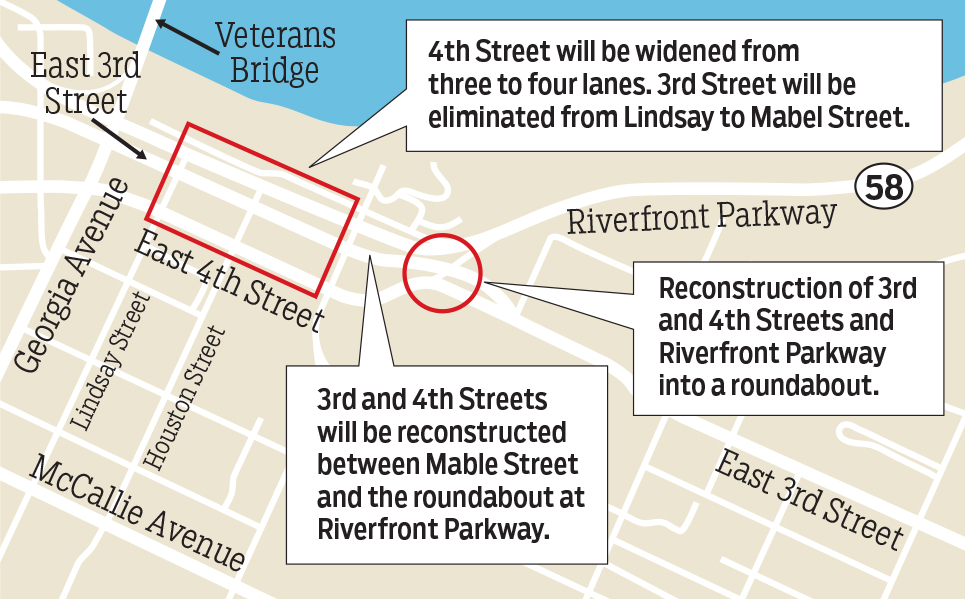On weekday evenings, rush hour traffic barrels - or creeps - down the Fourth to Third Street thoroughfare, most cars never bothering to stop anywhere along the stretch as they travel from work to home.
But within a decade, Erlanger, UTC and other Chattanooga institutions hope to see the heavily-trafficked commuter highway transformed into a lively, urban boulevard that is its own after-work destination.
They want to see housing along the strip, interspersed with retail and eateries, maybe even a hotel. They envision calmer traffic, wider sidewalks, green space and bike lanes.
Instead of the lonely wail of ambulance sirens echoing down the empty road at night, they want to hear the sounds of life.
"We need to bring life to this street," said Bruce Komiske, Erlanger Health System's vice president of new hospital construction. "We want to see people walking down the sidewalk to get groceries, or getting dinner across the street."
Erlanger's plans to transform its campus with a new children's hospital is drawing fresh attention to Third Street just as City Hall and major institutions along the road take a more expansive view of the street's future.
"A street like Third could go from a traffic connector to being a better place itself," said Macon C. Toledano, associate director of the Lyndhurst Foundation. "It becomes a street that isn't just functional, but amenable to the people who live and work there."
The foundation just last week awarded downtown redevelopment group River City Co. a $250,000 grant for an economic impact study on the revitalization of Fourth and Third Street from the Highway 27 exit near Cameron Hill past Chattanooga's historic Engel Stadium on Central Avenue.
The timing of Erlanger's plans "couldn't be more perfect," River City CEO Kim White said.
"We've been working on so many components of [Third Street revitalization] in separate silos," White said. "When Erlanger came to the table with what they want to do, we felt they were the catalyst for a whole new economic development corridor."
In the coming months, River City plans to join with Erlanger, city officials, the University of Tennessee at Chattanooga, Unum and other nearby companies to develop a new vision for the street, she said.
At the same time, city transportation planners are pushing forward 15-year-old plans to reconfigure intersections on East Third and Fourth streets and extending Central Avenue to meet Amnicola Highway - a plan they say will improve traffic flow and street safety.
Meanwhile, UTC wants to bring a new health sciences building to the block near Erlanger, and is planning to repurpose Engel Stadium into a sports complex for students and the community.
"Right now there are just large, empty gaps, and it is just not very pedestrian-friendly," university spokesman Chuck Cantrell said of the street. "But if students could travel down a road that is more inviting and has more activity - that would make all the difference."
Unum is looking to eventually redevelop its surface parking lots along Fourth Street, and recently had River City help design renderings for mixed-use buildings there.
White said the Lyndhurst grant will help bring all the players to the table in hopes of creating what Erlanger officials and others have dubbed a "health and wellness innovation district."
BUSY, YET EMPTY
Third Street is already a major economic artery.
It is the downtown connector for many urban neighborhoods, linking east to west. It touches major city institutions: the edge of BlueCross BlueShield of Tennessee headquarters; the Creative Discovery Museum; Unum; Blood Assurance; Chattanooga School of Arts and Sciences; Siskin Hospital; UTC; the Chattanooga-Hamilton County Health Department and Erlanger - all before linking to East Chattanooga neighborhoods and running toward the city's two other hospitals, Parkridge Medical Center and CHI Memorial.
Still, all these institutions remain their own islands - even downtown. Many of the buildings have "their backs turned" to the street, White said. Parking is behind the buildings, and there is barely any foot traffic.
"The big companies along the road have continued to develop, but without necessarily thinking about how they work together," Toledano said.
Part of the problem is that the city "essentially designed a highway in a downtown residential area," explained City Transportation Director Blythe Bailey.
When the city widened the road and built the a fly-over bridge at Third and Fourth streets to funnel traffic underneath onto Amnicola Highway, it failed to consider how such a busy road may isolate businesses and neighborhoods, he said.
Redeveloping the Third Street area hinges on the city's plans for the intersection improvements and the Central Avenue extension.
Overhauling and adding intersections between Georgia and Central avenues should allow traffic on secondary streets to better filter onto the road, alleviating buildup. Plans call for replacing the fly-over bridge with a roundabout.
"This creates better traffic patterns not only for cars, but for bikes and people, [and] for the neighborhood health and economic health as well," said Bailey.
The Chattanooga City Council voted to take the first step towards the overhaul in March. An environmental evaluation has begun on that $15 million project - most of which will be federally funded - and community meetings will be set for summer.
The Central Avenue extension, meanwhile, is still in the environmental study phase. That process has taken much longer than city leaders had originally hoped.
Residents in Lincoln Park, the historically black neighborhood that borders that side of Central Avenue, have opposed the project. The neighborhood association has tried to block it, filing state and federal complaints saying the extension discriminates against the community.
Two years ago, Erlanger agreed to swap five acres of Lincoln Park land it owns to the city for restoration as a public park. But residents say the extension cuts into the historical park, and that the mayor's office has moved forward with plans without consulting the neighborhood.
Bailey said the administration has met repeatedly with community members to hear their wishes. The extension, he says, will be no bigger than three lanes and will have streetscaping that is pedestrian-friendly on both sides.
"This was never intended to be a major thoroughfare," he said. "It is vitally important to this project that the park remain in place and that this is an asset to the community."
HOSPITAL, UTC PLANS
Changes to the Central Avenue layout will bring the back side of Erlanger "back to life," said Komiske, while Erlanger executives see the new children's hospital as the hospital's new face.
They are aiming for an eight- to 10-year time line. The first phase is the $35 million children's ambulatory center across Third Street from the hospital. Next would be turning the hospital's current ambulatory wing into a stroke and neuroscience center.
The final, largest phase - estimated right now to be around $300 million - will be an inpatient children's hospital across Third Street that connects to a new women's hospital and NICU to be built on the hospital's current footprint.
Erlanger leaders say they're approaching the project "bite by bite."
The hospital, which lost money for three years in a row until last year, has begun to see a financial turnaround under CEO Kevin Spiegel. The hospital was recently issued $70 million from bonds to put towards current expansion projects at downtown and East campuses.
For the entire children's hospital project, the hospital hopes to raise an estimated $55 million from donors, hospital officials say.
And hospital leaders hope to see the tired strip of buildings across Third Street transformed by private developers into housing, medical offices, retail and an 80-120 room hotel where patients and their families could stay.
Erlanger officials hope the buildings' owners will agree to bundle their parcels for a large-scale development instead of selling them separately.
"We have told them that we can't buy your property, but we can create a vision of what could be on your property," said Komiske. "We've asked them to allow us to market your properties as a group to developers."
Erlanger also hopes to have a closer neighbor in UTC.
Cantrell said the university wants a more defined presence there as it seeks to grow its enrollment from 12,000 students to 15,000.
"The health sciences fields are exploding; we can't graduate enough people in those areas," Cantrell said. "If we could locate a health sciences building near Erlanger to develop that synergy, it would really benefit us."
Preliminary Erlanger renderings show that building where the Chattanooga-Hamilton County Health Department now stands but Cantrell and county officials say there are no actual plans for a site.
A total Third Street overhaul would take at least a decade, White says, but Chattanooga has proven it can achieve a vision over time.
"I go back and look at the first 20-year master plan that was done with the riverfront, and the pictures that were drawn early on. And, by George, we did it," she said. "It doesn't always turn out that way. But unless you cast a vision get people to the table - that's the only way it happens."
Contact staff writer Kate Belz at kbelz@timesfreepress.com or 423-757-6673.


